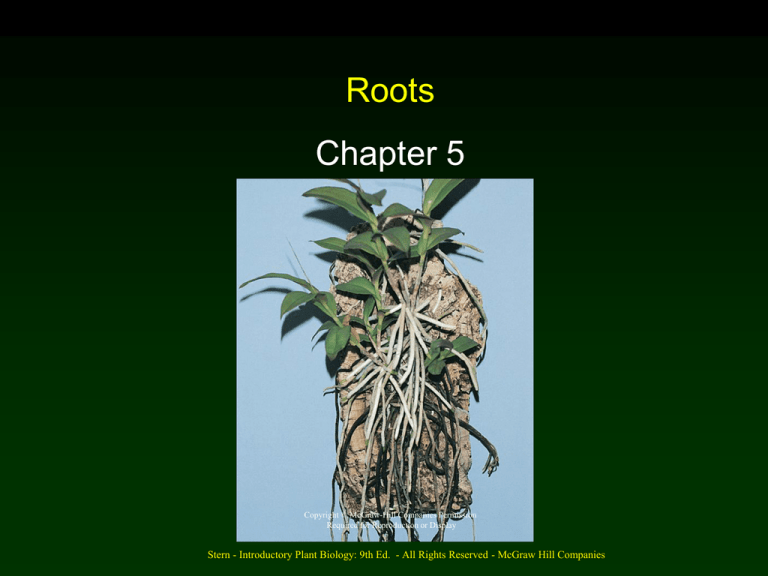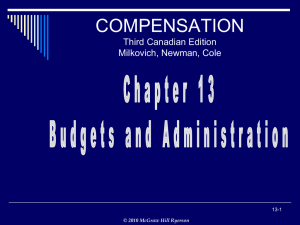
Roots
Chapter 5
Copyright © McGraw-Hill Companies Permission
Required for Reproduction or Display
Stern - Introductory Plant Biology: 9th Ed. - All Rights Reserved - McGraw Hill Companies
Outline
•
•
•
•
•
•
Root Function
Root Development
Root Structure
Specialized Roots
Mycorrhizae
Root Nodules
Stern - Introductory Plant Biology: 9th Ed. - All Rights Reserved - McGraw Hill Companies
Function
•
•
There are several functions for a root
Anchorage
Water and mineral absorption/conduction
Storage
- Starch
- Water
Extensive underground organ
A single grass plant
6
3
- 15 x 10 roots = 400 miles of root / 2 ft
soil
Stern - Introductory Plant Biology: 9th Ed. - All Rights Reserved - McGraw Hill Companies
Stern - Introductory Plant Biology: 9th Ed. - All Rights Reserved - McGraw Hill Companies
How Roots Develop
•
When a seed
germinates, the
embryo’s radicle grows
out and develops into
the first root.
Stern - Introductory Plant Biology: 9th Ed. - All Rights Reserved - McGraw Hill Companies
Root development
Radicle
Stern - Introductory Plant Biology: 9th Ed. - All Rights Reserved - McGraw Hill Companies
Development: Tap root -- Fibrous root
•
•
May develop into thick
taproot with branch roots.
Dicotyledonous Plants
May develop a fibrous root
system.
Monocotyledonous
Plants
Adventitious roots are
roots that develop from
non-root plant
partsBoth monocots
and dicots
Stern - Introductory Plant Biology: 9th Ed. - All Rights Reserved - McGraw Hill Companies
Adventitious Roots
Stern - Introductory Plant Biology: 9th Ed. - All Rights Reserved - McGraw Hill Companies
What are the advantages and disadvantages of
a fibrous and a taproot root system?
Advantages
•
•
Fibrous
Large surface area, increased access
to water and minerals
Taproot
Good for a storage of nutrients, can
access water and nutrients at great
depths, good during drought periods
Stern - Introductory Plant Biology: 9th Ed. - All Rights Reserved - McGraw Hill Companies
Disadvantages
•
•
Fibrous
Does not reach water and nutrients deep in
soil profile - not good during drought
Not good for storage of water or
carbohydrates
Taproot
Not as efficient as fibrous at getting water &
minerals in upper soil profile.
Stern - Introductory Plant Biology: 9th Ed. - All Rights Reserved - McGraw Hill Companies
ROOTS
•
•
•
•
•
•
Root Function
Root Development
Root Structure
Specialized Roots
Mycorrhizae
Root Nodules
Stern - Introductory Plant Biology: 9th Ed. - All Rights Reserved - McGraw Hill Companies
Root Structure
1.
2.
3.
4.
•
•
Root Cap
Region of Cell Division
Region of Cell Elongation
Region of Cell Maturation
Not all regions well-defined at their
boundaries.
Development in roots unlike other organs
follows a linear vector
Stern - Introductory Plant Biology: 9th Ed. - All Rights Reserved - McGraw Hill Companies
Root Structure and Root Tissue Comparison
Stern - Introductory Plant Biology: 9th Ed. - All Rights Reserved - McGraw Hill Companies
Root Structure
•
Root Cap - Thimbleshaped mass of
parenchyma cells covering
each root tip.
Protects tissue from
damage.
Function in gravity
perception.
Cells secrete a slimy
substance and slough
off forming a slimy
lubricant that helps roots
move through soil
Stern - Introductory Plant Biology: 9th Ed. - All Rights Reserved - McGraw Hill Companies
Region of Cell Division
• Root apical meristem
• 12 to 36 h cell cycle
Stern - Introductory Plant Biology: 9th Ed. - All Rights Reserved - McGraw Hill Companies
Region of Elongation
•
•
About 1 cm from root
tip
Cells become several
times their original
length.
Vacuoles merge and
form 90% of the
mature cell
Stern - Introductory Plant Biology: 9th Ed. - All Rights Reserved - McGraw Hill Companies
Region of Maturation
•
•
•
Sometimes called
“region of
differentiation” or “roothair zone”
Most cells differentiate
into various distinctive
cell types.
Vascularization and
development of root
hairs
Stern - Introductory Plant Biology: 9th Ed. - All Rights Reserved - McGraw Hill Companies
Region of
maturation
Root hairs
Tuberous
extensions of
specialized
epidermal cells
•
•
Absorb water and minerals and adhere tightly to soil
particles.
Grass plant 2ft3 soil, 15 x 106 roots has 14 x 109 root hairs
-
•
Root surface area ~ volleyball court
Root hair surface area ~ football field
Root hairs function for 2 days to 3 weeks
Stern - Introductory Plant Biology: 9th Ed. - All Rights Reserved - McGraw Hill Companies
Region of MaturationCortex cells
•
•
Cortex cells mostly store food
Between epidermis and inner
tissues.
Has endodermis as inner
boundary (single layer cells)
- Cell walls impregnated with
suberin bands; Casparian
Strips.
Forces all water and
dissolved substances
entering and leaving the
central core to pass
through plasma
membranes of the
endodermal cells.
Stern - Introductory Plant Biology: 9th Ed. - All Rights Reserved - McGraw Hill Companies
Region of MaturationCortex cells
Stern - Introductory Plant Biology: 9th Ed. - All Rights Reserved - McGraw Hill Companies
Region of Maturation
•
Vascular Cylinder lies at the inside of the
endodermis. (xylem/phloem)
Stern - Introductory Plant Biology: 9th Ed. - All Rights Reserved - McGraw Hill Companies
Development of Secondary Roots
•
Pericycle lies directly against the inner boundary of
the endodermis.
Lateral (branch) Roots develop
Stern - Introductory Plant Biology: 9th Ed. - All Rights Reserved - McGraw Hill Companies
What structure within the root is responsible
for forming secondary or lateral roots?
•
•
•
•
•
A. Casparian strip
B. Vascular cambium
C. Cork cambium
D. Pericycle
E. Endodermis
Stern - Introductory Plant Biology: 9th Ed. - All Rights Reserved - McGraw Hill Companies
Specialized Roots
•
Food Storage Roots
Sweet Potatoes
Yams
•
Store starch,
carbohydrates
Stern - Introductory Plant Biology: 9th Ed. - All Rights Reserved - McGraw Hill Companies
Specialized Roots
•
Carrots, beets, turnips, radishes are foodstorage tissues that are a combination of
root and stem
Stern - Introductory Plant Biology: 9th Ed. - All Rights Reserved - McGraw Hill Companies
Specialized Roots
•
•
Manroot (Marah)
Water Storage Roots
Pumpkin Family
Propagative Roots
Adventitious Buds
develop into
suckers.
- Fruit Trees
Sisal
Stern - Introductory Plant Biology: 9th Ed. - All Rights Reserved - McGraw Hill Companies
Specialized Roots
•
Pneumatophores
Spongy roots that
extend above the
water’s surface and
enhance gas
exchange between
the atmosphere and
subsurface roots.
Mangroves
Stern - Introductory Plant Biology: 9th Ed. - All Rights Reserved - McGraw Hill Companies
Specialized Roots
•
Aerial Roots-can
absorb water from the
air; has a thick
epidermis to reduce
water loss
Orchids
Banyan trees
www.hcs.ohio-state.edu/ hcs300/anat1.htm
Stern - Introductory Plant Biology: 9th Ed. - All Rights Reserved - McGraw Hill Companies
Specialized Roots
•
•
Contractile Roots
Pull plant deeper into the soil.
- Lilly Bulbs.
Buttress Roots
Stability - Tropical Trees.
Stern - Introductory Plant Biology: 9th Ed. - All Rights Reserved - McGraw Hill Companies
Mycorrhizaefungi
•
Mycorrhizae form a mutualistic association with
plant roots. (found in3/4 of all seed plants)
Fungus is able to absorb and concentrate
phosphorus much better than it can be absorbed
by the root hairs.
Stern - Introductory Plant Biology: 9th Ed. - All Rights Reserved - McGraw Hill Companies
Mycorrhizaefungi
Two Hibiscus plants. Left
plant without Mycorrhizae,
right with Mycorrhizae.
Mucorrhizal
arbuscule inside a
plant cell
www.botany.hawaii.edu/faculty/ wong/BOT135/Lect26.htm
Stern - Introductory Plant Biology: 9th Ed. - All Rights Reserved - McGraw Hill Companies
Root Nodules
•
Few species of bacteria (Rhizobium) produce
enzymes that can convert nitrogen into
nitrates and other nitrogenous substances
readily absorbed by roots.
Legume Family (Fabaceae)
- Root nodules contain large numbers of
nitrogen-fixing bacteria.
Stern - Introductory Plant Biology: 9th Ed. - All Rights Reserved - McGraw Hill Companies
Root Nodules
Stern - Introductory Plant Biology: 9th Ed. - All Rights Reserved - McGraw Hill Companies
Review
•
•
•
•
•
Root Development
Root Structure
Specialized Roots
Mycorrhizae
Root Nodules
Stern - Introductory Plant Biology: 9th Ed. - All Rights Reserved - McGraw Hill Companies









